Best brake pad backing plate — what to look for
The best brake pad backing plates are made from galvanized steel
The quality of the brake pad backing plate determines brake pad life
Recent studies show that brakes simply aren’t lasting as long as they’re supposed to. A recent study by Frost and Sullivan shows that brakes are being replaced 34% more often than they should be. That finding is backed up by field studies conducted by the Global Brake Safety Council (GBSC). Those studies show that poor quality steel backing plates are the culprit, causing a large number of brake pads to fail way before the friction material is used up.
Aren’t all backing plates the same?
OE brake parts safety standards DON’T apply to the brake pads you buy at auto parts stores or the brake pads installed by repair shops. These “aftermarket” brake pads can be made to fit any vehicle without matching the car maker’s original specifications. When poor quality steel is used in the brake pad backing plate, you put your safety is at risk.
What is a high quality backing plate?
A high quality brake pad backing plate doesn’t rust. It’s made from a high quality steel and rust-proofed with a sacrificial galvanized zinc coating. It doesn’t require paint because the galvanized coating provides all the protection. A high quality backing plate is flat. Surface irregularity causes bonding and flexing issues. A high quality backing plate is stamped and finished to exacting dimensions. A high quality backing plate doesn’t flex during application.
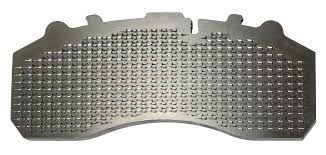
High quality galvanized steel backing plate. Photo Courtesy of Nucap Corporation
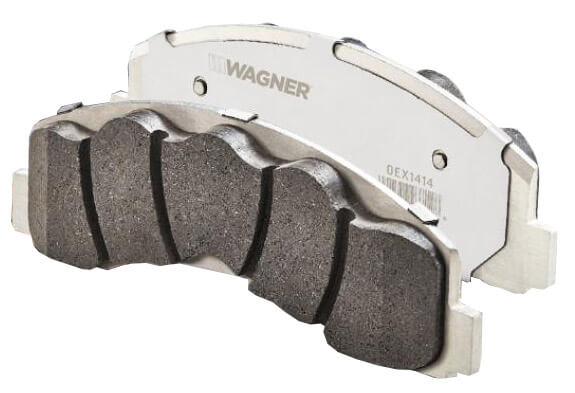
Wagner and NRS brake pads are made with galvanized steel backing plates
What is a low quality backing plate?
A low quality backing plate is made from low quality black steel. A low quality backing plate rusts, even if it’s been painted. A low quality backing plate isn’t flat. A low quality backing plate doesn’t meet OE dimensional requirements.
When steel rusts, the oxide buildup grows and exerts outward
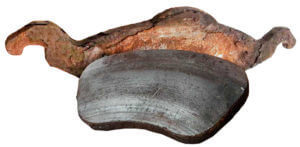
Total brake pad separation caused by backing plate rust
pressure on attached components. This phenomenon is called “oxide jacking” or “rust jacking.” When a low quality backing plates rusts, the rust bloom literally pushes the friction material off the backing plate. Rust is stronger than the bonding adhesive. In addition to applying even braking force to the friction material, the steel backing plate also helps dissipate heat. When rust breaks the friction material bond, the backing plate can no longer dissipate heat. In fact, the rust acts almost as insulating membrane, preventing heat transfer from the friction material to the plate. So the friction material overheats, cracks and breaks off. “Rust jacking” also affects the abutment tabs, causes a loss of clearance between the tab and the anti-rattle clips which results in pad binding and failure to release.
Paint doesn’t stop rust on black steel
You can’t put lipstick on a pig and you can’t paint low quality steel to prevent rust. The GBSC study conducted salt spray tests on painted black steel using an industry standard (ASTM B117) salt spray test. To pass, the painted steel must show no more than 5% red rust after 96-hours of contact with salt spray. Yet all of the test samples failed after just 20-hours! Worse yet, the rust caused the all the backing plates to be out of spec in critical areas. See the results below.
What is black steel?
When steel is hot rolled at the mill, the hot surface develops mill scale. Mill scale is actually iron oxide, and it can degrade the bond between the friction material and the backing plate. If the iron oxide isn’t removed properly, the backing plate can develop “rust jacking,” where the rust formation builds and actually pushes the friction material away from the backing plate.
Once stamped, dubious brake pad manufacturers often remove mill scale by shot blasting. Then they paint the “cleaned” backing plates. Unfortunately, shot blasting can deform and compromise the backing plate’s critical dimensions. Once compromised, those altered dimensions can affect fit, function and even safety when installed on the vehicle.
Salt spray tests conducted by GBSC on these black steel backing plates show that after 96 hours of contact with an industry standard salt spray (ASTM B117) 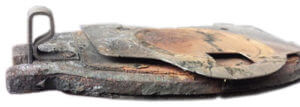 test all of the painted black steel backing plates failed the test. To pass, the steel plates must show no more than 5% red rust. Worse yet, all of the samples failed before the test passed the 20-hour mark. Not only did the backing plates show rust, but most showed out of spec dimensions in critical areas. Some of these inexpensive backing plates were out of tolerance right out of the box!
test all of the painted black steel backing plates failed the test. To pass, the steel plates must show no more than 5% red rust. Worse yet, all of the samples failed before the test passed the 20-hour mark. Not only did the backing plates show rust, but most showed out of spec dimensions in critical areas. Some of these inexpensive backing plates were out of tolerance right out of the box!
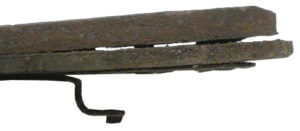
Rust jacking causes delamination. Photo courtesy Nucap Corporation
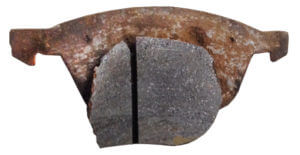
Brake pad friction material de-lamination AND break-off
Testing shows the dangers of substandard brake pads
The Global Brake Safety Council (GBSC) is an association of brake industry professionals dedicated to safety of the driving public by testing brake products and making recommendations to the brake manufacturing industry.
Over the past three years the GBSC has conducted two field studies on new and used brake pads to determine common failure modes and conformance to OE specifications. The GBSC collected 6,800 brake pads from Toronto, Ontario, Houston, TX and Cleveland, OH. The sites were picked because of the climate in those areas, the use of road salt, and the incidence of high humidity.
GBSC tests show glaring brake pad safety issues
The GBSC collected 6,800 brake pads from Toronto, Ontario, Houston, TX and Cleveland, OH. The sites were picked because of the climate in those areas, the use of road salt, and the incidence of high humidity. The goal was to determine the most common failure modes for brake pads.
The steel backing plate should last for the life of the friction material. However, the study showed that 51.1% of all the sample brake pads showed signs of rust that’s so severe it actually reduced the life of the brake pad and, in some cases, even put the drivers at risk. Here’s what they found.
Excessive Backing Plate Rust
11.8% of the brake pads showed evidence of corrosion on the backing plate abutment
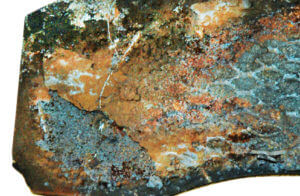
Black steel backing plate corrosion. Photo courtesy Nucap Corporation
areas and de-lamination of the noise reduction shim. Corrosion at the brake pad abutment can cause the brake pad to bind. That in turn can prevent the pad from releasing, resulting in rapid wear, noise and overheating. The expanding force of rust, or “rust jacking” also forces the noise reduction shim off the backing plate, which can cause the shim to shift and jam in the caliper. A failure to release causes not only rapid friction wear and rotor overheating but also creates drag and brake pull, along with poor performance and increased fuel consumption. Drivers also notice a substantial increase in high pitched brake squeal.
Pad Edge Lift
27.0% of the brake pads showed a bonding failure between the friction material and the backing plate caused by rust. The bond between the friction block and backing plate is supposed to last the life of the pad. Brake pad manufacturers often paint the backing plate after bonding
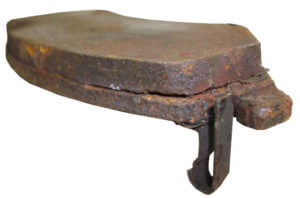
Brake pad de-lamination caused by rust jacking.
Photo courtesy Nuccap Corporation
the friction material. But friction material de-lamination caused by rust is a sign of low quality “black” steel, poor cleaning and preparation or poor quality paint/rust prevention measures. De-lamination is a safety issue because it’s the precursor to friction material break-off and separation.
Broken or Separated Friction
6.3% of the brake pads had portions of friction material missing or broken away from the backing plate. This is a MAJOR safety issue. Missing friction material increases stopping distances dramatically.
Brake pad backing plate flex causes internal cracking as well. This will cause friction material to break-off
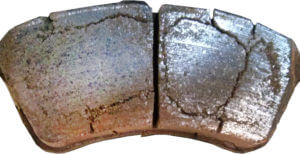
Brake pad backing plate flex causes friction material cracking and break-off
Global Brake Safety Council Test Results on New Brake Pads
“Of the thirty two (32) disc brake pads measured prior to testing, many of the pads from sets 7 and 8 had critical dimensions already out of the OE specified tolerance. Evidently, these samples were manufactured out of the operational limits of the OEM even before they were subjected to salt spray.
The frequency of the out of tolerance parts indicates poor dimensional capabilities in the stamping process. It is also possible the manufacturer does not know what the actual dimensional tolerances are for this particular vehicle application and has designed their tooling based on incomplete reverse engineering.
Sets 1, 2, 7, and 8 each had flatness exceeding the maximum tolerance on several pads. This could partially be for the same reasons as above, especially considering how far out of tolerance these disc brake shoes were. The OES set and set 4 each had one pad slightly over the maximum flatness specification. It is reasonable to conclude that the same residual stresses that pulled in on the abutment dimensions may also have disrupted the flatness on all of the pads during the tumbling operation.”
All the tested brake pads showed in increase in critical dimensions after the salt spray test. Average growth was 0.10-mm. The largest increase was 0.25-mm, with some samples showing an increase of as much as 0.50-mm.
Backing plate dimensions are critical to proper pad movement.
As shown in the study, many backing plates were outside of OE specs right out of the box. If
the backing plate is too tall, it can bind in the abutment areas causing uneven (tapered) pad wear or uneven inboard/outboard pad wear. If the abutment portions are too small, the pad will rattle. When you combine dimensional problems with corrosion and rust jacking, you get seized brake pads, resulting in poor braking, uneven brake pad wear and dramatically lower pad life.
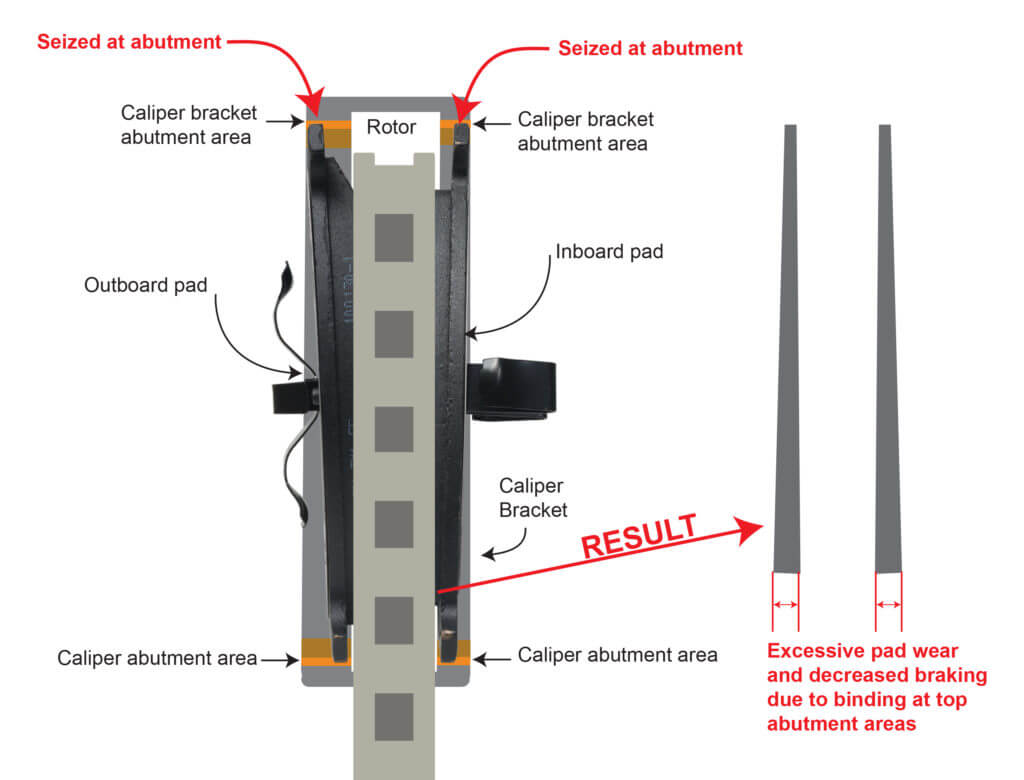
Excessive brake pad wear and decreased braking performance due to improper backing plate length which causes binding
Mid-grade: 3 of 4 samples exceeded the upper tolerance limit
Next, the GBSC tests examined metallographic cross sections using Scanning Electron Microscopy, X‐Ray Spectrometry, and Microstructural Analysis. The report showed:
Iron oxides (mill scale) were found embedded in subsurface locations of the black steel samples and in the bond layer of suspected black steel disc brake pads.
The only effective ways to combat backing plate rust
• GBSC tests proved that backing plates made from SAE 1010 hot rolled steel with mill scale removed by acid cleaning (commonly called pickling) followed by oiling resists rust better than black steel. Plus, they hold their dimensional stability better. Further, GBSC test show that additional zinc plating further protects the steel from rust.
• Shot blasting should not be considered an acceptable method of removing all mill scale from disc brake shoes.
• Shot blasting the disc brake shoe after it has been stamped to the required tolerances may deform and compromise critical dimensions of the disc brake shoe causing fit, function, and safety issues in the brake caliper assembly.
See my next article on the next generation of brake pad backing plates that are stamped to exacting specifications, eliminate rust and mechanically bond the friction material to the backing plate. Nucap’s new NRS backing plate outlasts the friction material!
Why the sudden increase in backing plate failures?
Simple. Strong price competition from new players, a flood of low priced offshore brake products and a lack of federal regulations have created a situation where substandard brake pads are marketed and sold as replacements for OE brakes. In the past, independently owned repair shops, dealers and franchised tire shops used to perform the bulk of all brake repairs. Now they have major competition from muffler shops that continually advertise low cost ($99 to $149) brake job “specials” that include a “lifetime” brake pad warranty. That’s put severe pressure on the brake parts manufacturers. Many brake parts manufacturers have responded by manufacturing economy versions of their product that have more filler, less of the expensive fibers and resins and thinner cheaper steel backing plates. Or, they may simply source economy brake pads from an offshore supplier and package them as an economy version of their name brand product. The result is a dramatic decrease in brake pad quality.
Low brake pad quality is a MAJOR safety issue that puts you at risk
As rust forms, it builds height and that height lifts the friction material off the backing plate causing cracking and delamination, which decreases braking performance. Worse yet, rust jacking breaks off portions of the friction material, so you’re braking on only a portion of the friction material. Watch what happens when you try to stop a vehicle when a portion of the brake friction material is missing.
DISCLAIMER: In accordance with Federal Trade Commission (FTC) rules regarding endorsements, I have not received any financial remuneration from NUCAP or any other company in return for posting this press release on my site.
©, 2019 Rick Muscoplat
Posted on by Rick Muscoplat